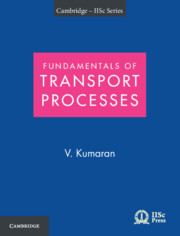Book contents
- Frontmatter
- Dedication
- Contents
- Preface
- 1 Introduction and Dimensional Analysis
- 2 Dimensionless Groups and Correlations
- 3 Diffusion and Dispersion
- 4 Unidirectional Transport: Cartesian Co-ordinates
- 5 Unidirectional Transport: Curvilinear Co-ordinates
- 6 Pressure-driven Flow
- 7 Conservation Equations
- 8 Diffusion Equation
- 9 Forced Convection
- 10 Natural Convection
- Bibliography
- Index
9 - Forced Convection
Published online by Cambridge University Press: 28 February 2025
- Frontmatter
- Dedication
- Contents
- Preface
- 1 Introduction and Dimensional Analysis
- 2 Dimensionless Groups and Correlations
- 3 Diffusion and Dispersion
- 4 Unidirectional Transport: Cartesian Co-ordinates
- 5 Unidirectional Transport: Curvilinear Co-ordinates
- 6 Pressure-driven Flow
- 7 Conservation Equations
- 8 Diffusion Equation
- 9 Forced Convection
- 10 Natural Convection
- Bibliography
- Index
Summary
Transport of heat/mass is enhanced by an externally generated flow past an object or a surface in ‘forced convection’. Here, the flow is specified, and it is not affected by the change in temperature/concentration due to the heat/mass transfer. The known fluid velocity field is substituted into the convection–diffusion equation in order to determine the temperature/concentration field and the transport rate.
In the previous chapter, we examined the limit of low Peclet number, where transport due to convection is small compared that due to diffusion. There, the approach was to neglect convection altogether, and solve the diffusion equation. In the limit of high Peclet number, an equivalent approach would be to neglect diffusion altogether, and solve the convection equation to obtain the concentration/temperature fields. This approach is not correct for the following mathematical and physical reasons.
Mathematically, when the diffusion term is neglected, the convection–diffusion equation is reduced from a second order to a zeroth order differential equation in the cross-stream co-ordinate. The second order differential for the concentration/temperature field is well posed only if two boundary conditions are specified in each co-ordinate. When diffusion is neglected, the resulting zeroth order equation cannot satisfy both boundary conditions in the cross-stream co-ordinate specified for the original problem. Physically, when diffusion is neglected, there is transport due to convection only along fluid streamlines, and there is no transport across the streamlines. The concentration/temperature is a constant along streamlines in the flow. At bounding surfaces (the pipe surface in a heat exchanger, or particle surfaces in the case of suspended particles), there is no flow perpendicular to the surface. When we neglect diffusion, there is no flux across the surface. Therefore, we obtain the unphysical result that there is no mass/heat transfer across the surface.
A more sophisticated approach is required to obtain solutions for transport in strong convection, based on the following physical picture. In the limit of high Peclet number, mass or heat diffusing from a surface gets rapidly swept downstream due to the strong convection, and so the concentration/temperature variations are restricted to a thin ‘boundary layer’ close to the surface.
- Type
- Chapter
- Information
- Fundamentals of Transport Processes with Applications , pp. 421 - 470Publisher: Cambridge University PressPrint publication year: 2023

